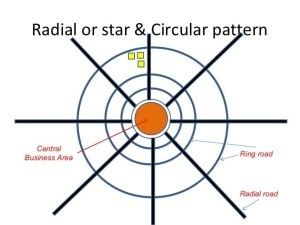Rectangular or block pattern:
The entire area is divided into rectangular plots, with streets meeting at right angles in this arrangement. The main road, which runs through the heart of the neighbourhood, should be adequately wide, while smaller branch roads may be narrow. The major road has a direct connection to the rest of the city.

Hexagonal pattern:
The entire area is covered in this style by a network of roadways that create hexagonal figures. Three roads meet the built-up area boundary at each hexagon’s corner, and the sides of the hexagons are further divided into appropriate sizes.

Radial or star and block pattern:
The entire area is organised into a network of roadways extending outwards from the business in this pattern. The built-up region between radiating main roadways could be developed with rectangular blocks.

Radial or star and circular pattern:
The primary radial roads extending from the central business centre are linked together with concentric roads in this design. The built-up area is planned using a curved block system in these locations, which are bordered by nearby radial highways and equivalent circular roads.

Radial or star and grid pattern:
Because street patterns are the most persistent physical aspect of any layout, a change in direction could potentially contribute to systematic site planning and, as a result, merits deeper examination. Despite the fact that the network is completely interconnected, north-south movement becomes tortuous, difficult, and cumbersome, making driving an improbable option and demonstrating that interconnection is insufficient to ease movement.

